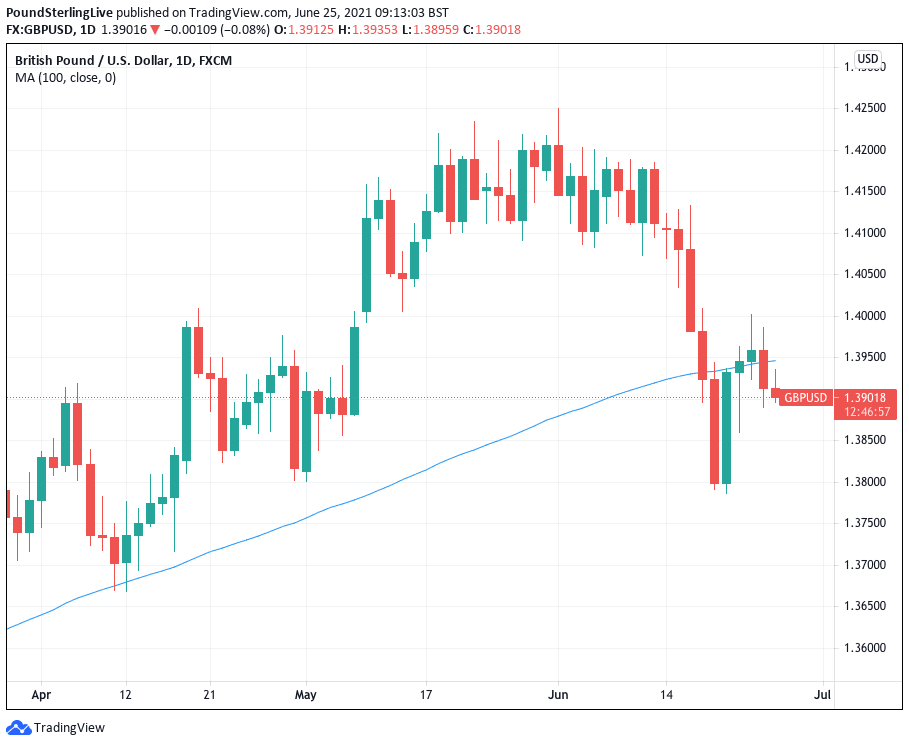Pound-Dollar Rate Back Under Pressure, Could be Entering a More Enduring Period of Weakness
- Written by: Gary Howes
-

Image © Adobe Images
- GBP/USD reference rates at publication:
- Spot: 1.3896
- Bank transfers (indicative guide): 1.3527-1.3624
- Money transfer specialist rates (indicative): 1.3780-1.3817
- More information on securing specialist rates, here
- Set up an exchange rate alert, here
The Pound has ahead of the weekend failed to rebound from the lows triggered in the wake of the Bank of England policy update and is in fact looking decidedly more heavy.
The Pound-to-Dollar exchange rate (GBP/USD) has fallen below the 1.39 level and is quoted at 1.3896 at the time of writing, leading analysts to expect a test of the June 21 lows.
"GBP-USD suffered, as feared, from the lack of a hawkish tone from the BoE at the end of the MPC meeting. In contrast, the bank made it clear that it will not tighten until it sees clear evidence of progress towards its goal, although it acknowledged that risks to the downside for the UK economy had reduced," says Roberto Mialich, FX Strategist at UniCredit Bank in Milan.
A look at the chart below shows a notable technical development in that the GBP/USD rate has fallen below the 100 day moving average, a signal to many market participants that the trend has turned lower in a potentially more decisive manner.
Above: GBP/USD daily chart showing the fall below the 100 day moving average.
Secure a retail exchange rate that is between 3-5% stronger than offered by leading banks, learn more.
"Cable has now dipped back below the 100-day moving average, pulling further away from the wall of sellers encountered at the 1.40 handle on Wednesday," says Michael Brown, Senior Market Analyst at CaxtonFX.
The British Pound was sold after an optimistic Bank of England didn't quite meet the lofty expectations build up by investors ahead of its June policy meeting.
The Bank showed it was in no rush to raise interest rates with the statement issued following the meeting revealing policy setters view the current rise in inflation as being temporary, a potentially disappointing outcome for those in the currency market looking for more urgency.
All members of the Bank's Monetary Policy Committee (MPC) opted to keep interest rates unchanged but one member - Andy Haldane - voted to reduce the scale of quantitative easing by £50BN.
That no other members joined Haldane suggests the MPC is in no mood to bring forward expectations for tightening, which might have been a source of disappointment for those positioned for a rise in the Pound.
"Sterling fell prey to a small short term profit taking move as the BoE didn’t satisfy the needs of GBP bulls when it comes to normalization bets," says Mathias Van der Jeugt, an analyst at KBC Markets.
"GBP/USD in the run-up tried to conquer the 1.40 big figure (previous support), but afterwards dropped back towards the low 1.39 area. The near term trading band is 1.38-1.40," he adds.
Economists at the Bank revised up their expectations for the level of UK GDP in 2021 Q2 by around 1.5% since the May Report, as restrictions on economic activity have eased, so that output in June is expected to be around 2.5% below its pre-Covid 2019 Q4 level.
{wbamp-hide start}
GBP/USD Forecasts Q2 2023Period: Q2 2023 Onwards |
But despite any optimism on the outlook the MPC appear in no mood to raise interest rates.
The Bank mentioned that they view the delay to the final lifting of all covid restrictions, which were originally planned for June 21, as being of little consequence to the economic outlook.
Regarding inflation, the MPC expect the direct impact of rises in commodity prices on CPI inflation will be transitory, a view that effectively neuters any optimistic economic assessments seen elsewhere in their June policy update.
"Despite the Bank not delivering any surprises, GBP was sold to the tune of around 60 pips in the immediate aftermath of the decision. One would presume that this selling was a result of the market being positioned for a hawkish surprise going into the meeting, that obviously didn’t arrive. This is, in fact, rather odd, given near-unanimous expectations before the decision that the Bank would stick to the ‘status quo’," says Caxton FX's Brown.
The interpretation by the market that the June BoE event was 'dovish' contrasts with an interpretation that the Federal Reserve's June policy update was 'hawkish', creating a divergence in Pound and Dollar direction.
Foreign exchange analysts at Wall Street investment bank JP Morgan have said they are reinstating their bullish forecasts on the U.S. Dollar in the wake of the June Federal Reserve (Fed) policy update.
"The Fed’s hawkish pivot is a bullish watershed for USD after an indecisive 1H," says Paul Meggyesi, Head of FX Research at JP Morgan in a weekly currency research note.
The Dollar is the best performing major currency of the past month, having advanced 2.14% against the Euro, 1.72% against the Pound and 2.19% against the U.S. Dollar.
Should the Dollar have bottomed out the inference for other currencies is significant: for instance, it could well mean the top is now for the Pound-to-Dollar exchange rate (1.42) and Euro-to-Dollar exchange rate (1.2250).
"The Fed has removed the assurance of multi-year policy inaction that has been pivotal to the market's USD-bearish conviction ever since the switch to average inflation targeting," says Meggyesi.
"The dollar was well past its point of peak cyclical jeopardy even before the Fed unexpectedly brought US monetary policy back into play," adds Meggyesi.






